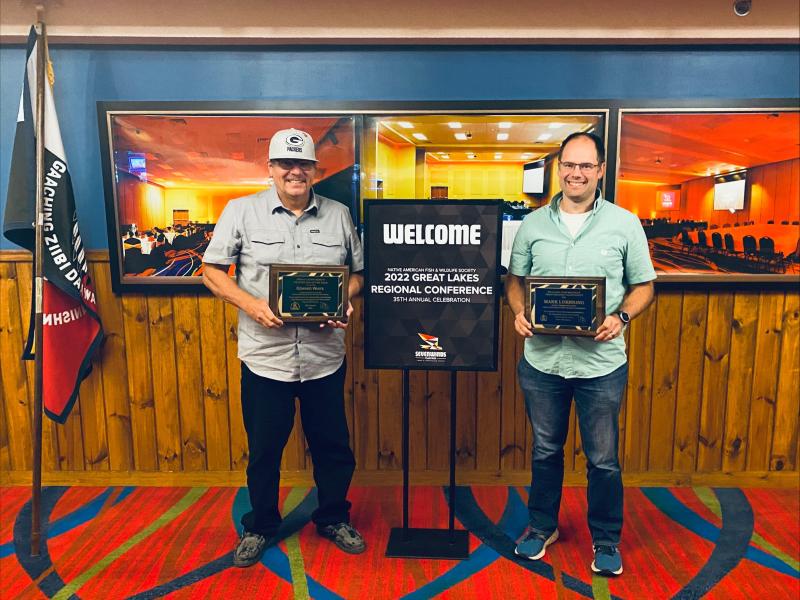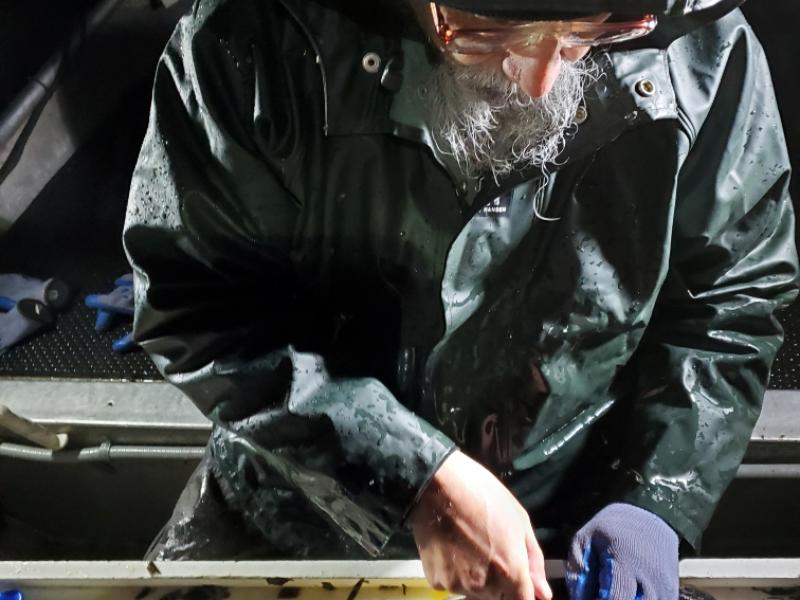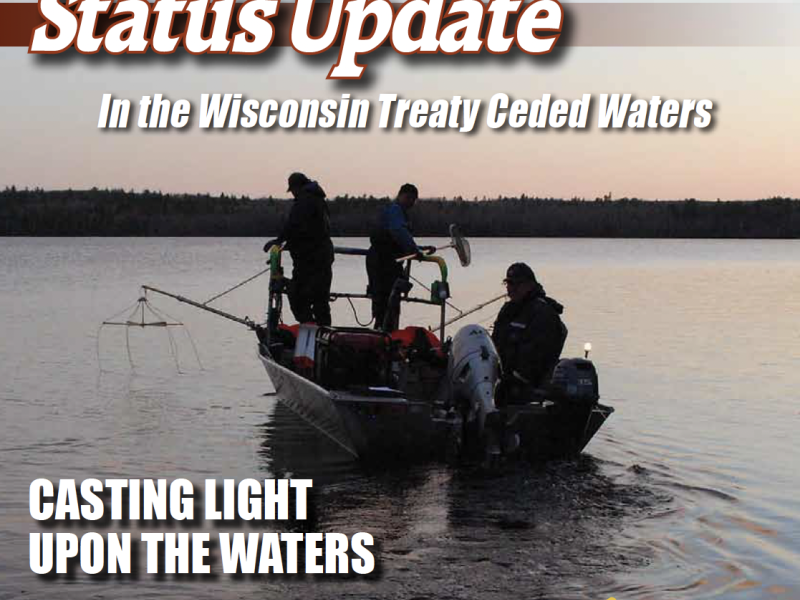GLIFWC biologists and technicians work to protect ceded territory fish populations and habitat through partnerships, surveys, research, and harvest monitoring in waters throughout the treaty Ceded Territories of Wisconsin, Michigan, and Minnesota.
Each spring and fall GLIFWC crews work with USFWS, Bad River, Fond du Lac, Mole Lake, and St. Croix crews to conduct assessment and recruitment walleye surveys. GLIFWC biologists also work closely with state biologists in all three states.
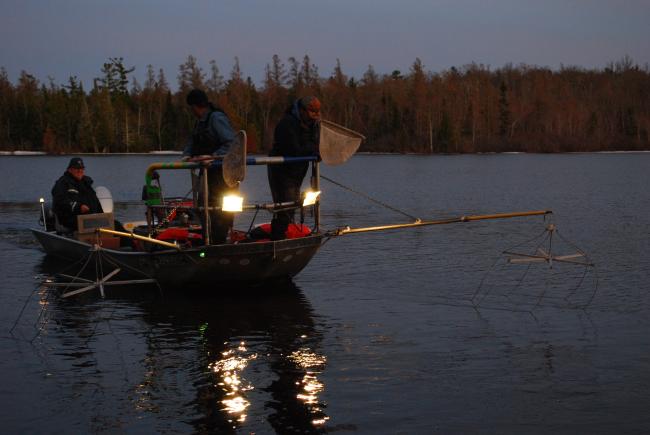
Each spring, crews head out to inland lakes to conduct walleye population estimates for adult fish during spawning season. Lakes are surveyed on a rotating basis.
I. Capture/Marking Survey
Shortly after "ice-out" electrofishing begins at dusk and continues until the entire shoreline (or a designated portion of the shoreline) has been surveyed. Electrofishing temporarily stuns fish so that they can be netted and placed in a recovery tank. Walleye are captured, measured, and sexed before getting a small fin clip or tag to identify the fish as being marked. For some fish, crews will also collect one of their spines to determine the approximate age of the bunch. Fish are then released.
II. Recapture Survey
One to three nights later, crews will make their way back around the shoreline to perform a recapture survey with electrofishing gear. Walleye collected during the recapture survey are sexed, measured, and examined for the presence of the fin clip or tag given during the initial marking surveys. The ratio of marked to unmarked walleye in the recapture sample is estimated to equal the entire lake's adult walleye population.
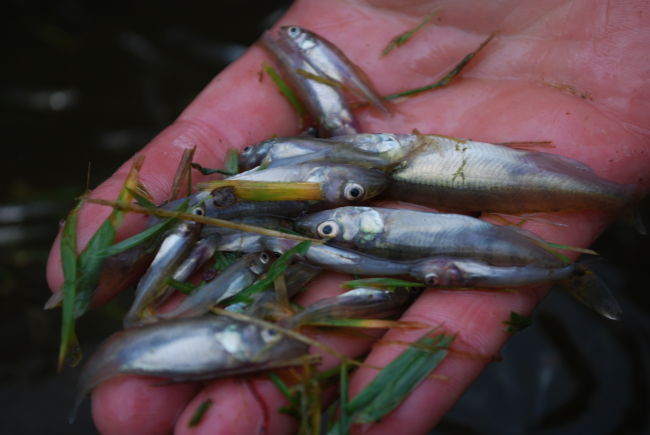
Fall Fingerling Survey
Each fall, crews assess “year-class-strength” of stocked or naturally reproduced juvenile walleye called, “fingerlings” that are age 0-age 1. Fingerlings hatched in the most recent spring are age 0, and those hatched in the previous spring are age 1.
Data from the fall surveys provide a snapshot of the trends in natural reproduction on important walleye lakes throughout the ceded territory. These data provide the first look at the possible future of the adult populations. In general, abundant naturally reproduced walleye that survive to their second fall have a good chance to make it to the adult populations. The data can also be used to determine whether most of the walleye in each lake are coming from natural reproduction or stocking.
All fish collected are identified by species and their length. Scale samples are collected from a subset of walleye, which are later examined to determine what lengths of walleye are age 0, age 1, or older. Then the fish are released.
Year-class strength is measured in catch per mile of shoreline surveyed for age 0 and age 1 walleye.
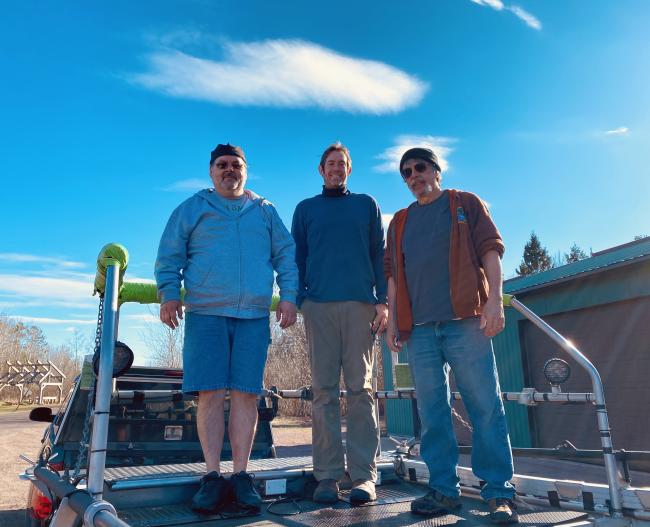
Accurate age estimation is an important part of sound fisheries management in the ceded territory. Biologists can use age information to estimate growth, mortality, age composition of populations and harvest, and other population parameters. Since fish growth is cyclic with fast growth occurring in the summer and slow growth in the winter, several different bony structures can be used to estimate fish ages by counting annuli like the rings on a tree.
- For walleye, scales, spines (from the dorsal fin), and otoliths (inner ear bones) are commonly used to estimate ages. Scales work well for younger fish, but annuli become difficult to distinguish in older fish since scale growth slows considerably. Spines work well for fish up to about age 10, but have the same issues as scales beyond that point. Otoliths are generally considered the best structure for accurate walleye age assessment, but otolith extraction requires killing the fish.
- For muskellunge, bones from the pectoral girdle called cleithra provide one of the few reliable ways to estimate age. Unfortunately, removal of cleithra is a lethal procedure. GLIFWC biologists obtain scales from age 0 and age 1 walleye during the fall recruitment surveys, and spines from walleye during the spring adult assessments. Otoliths are collected from the tribal walleye harvest on Mille Lacs Lake, and some cleithra are collected from the Wisconsin muskellunge spear harvest.
Quality habitat is critical for healthy fish populations. In the ceded territories, walleye populations thrive in lakes with cobble spawning areas and natural shorelines. GLIFWC is working with partners to improve and protect habitat for walleye and other fish species.

Because spearing is highly monitored, a wealth of information has been collected to describe this tribal fishery and the impact of that fishery on walleye populations.
Open water spearing and netting reports for each season are available here
Fish population assessments of Ceded Territory lakes are available here
Tribes set harvest quotas based on the best available population information for each lake, at levels that are intended to allow the population to thrive. During the season, harvesters must obtain a daily permit for individual lakes, and must have their catch fully counted at a designated location (usually the boat landing for the lake). GLIFWC creel clerks count, measure, and determine whether each fish is a male or female. Total harvest is tracked on a daily basis to make sure that the harvest does not exceed the quota.
GLIFWC and the Tribes collaborate with partners to conduct fisheries research projects to learn about how to improve fish populations and protect habitats. Current projects include:
- Hooking Mortality (How well do walleyes survive being caught and released?)
- Acoustic Telemetry in Mille Lacs (What are the habitats that are being used by the fish species in Mille Lacs? Is climate change causing predators to overlap in habitat with juvenile walleye?)
- Nearshore Habitat use in Lakes (What areas of lakes are being used for spawning by adults of different fish species? What areas are being used for nursery habitat by young fish?)
- Walleye Egg Predation (Do egg predators prevent the successful hatching and survival of walleye fry in Minocqua Lake?)
Protecting fish populations and habitats for future generations is a big undertaking that requires multiple partners pulling in the same direction. GLIFWC partners with individual tribal natural resource departments and Minnesota, Wisconsin, and Michigan DNRs to co-manage fish populations in the ceded territories. GLIFWC's inland fisheries section also seeks partnerships with lake groups and other organizations who are aligned with the goal of protecting fish populations and habitat. Partnerships are also an important part of GLIFWC’s research program, where GLIFWC researchers and those from other agencies and institutions bring their own expertise to research collaborations.
"Dive into this "tail" of walleye conservation, as our Into the Outdoors Adventure Team member, Zach, discovers the significance of this species culturally and environmentally. Zach talks with environmental experts, tribal members and state representatives to learn more about the threats walleyes are facing in today's changing climate."
Sustainable Ecosystems: Restroring Walleyes watch here
Casting Light on the Water, Fisheries Status Update is a report published every five years. Walleyes are a highly-valued resource, shared between state-licensed anglers and Ojibwe harvesters.
In treaty negotiations with the United States government, the Ojibwe reserved natural resource harvest rights in a vast region of northern Wisconsin known as the Ceded Territory. Today, Ojibwe tribes co-manage Ceded Territory natural resources with the state of Wisconsin.
Learn more about the history of Casting Light Upon the Water, Status of the Joint Fishery (1991)
